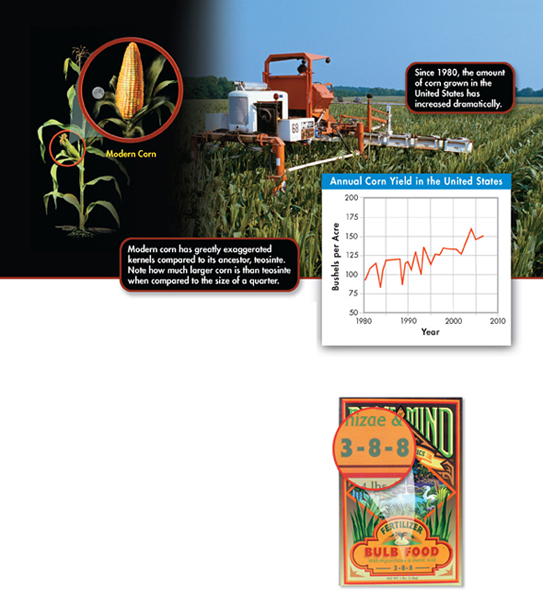Changes in Agriculture Between 1950 and 1970, a worldwide effort to combat hunger and malnutrition led to dramatic improvements in farming techniques and crop yields. This effort came to be called the green revolution because it greatly increased the world's food supply. Green revolution technologies enabled many countries to end chronic food shortages and, in some cases, become exporters of surplus food.
At the heart of the green revolution was the use of high-yield varieties of seed and fertilizer. For thousands of years, farmers have added essential nutrients in the form of natural fertilizers such as animal manure. While some farmers today still use these traditional methods, many farmers use artificial fertilizers.
Fertilizers are labeled with three numbers that reflect the percentage by weight of three elements: nitrogen (N), phosphorus (P), and potassium (K). A bag of garden fertilizer labeled “20-10-5” is 20 percent nitrogen, 10 percent phosphorus, and 5 percent potassium by weight.
Fertilizers and pesticides must be used with great care. Overfertilizing can kill crop plants by putting too high a concentration of salts into the soil. The intensive use of fertilizers can also affect the groundwater. When large amounts of nitrogen- and phosphate-containing fertilizer are used near wetlands and streams, runoff from the fields may contaminate the water. Pesticides can also pose a health risk. Chemical pesticides are poisons, and they have the potential to harm wildlife and leave dangerous chemical residues in food.
 In Your Notebook Write a paragraph summarizing the risks and benefits of modern agricultural practices.
In Your Notebook Write a paragraph summarizing the risks and benefits of modern agricultural practices.

FIGURE 24–23 Reading a Fertilizer Label Three numbers typically appear on a fertilizer label. Apply Concepts Describe what the numbers on this label mean.
dTable of Contents
- Formulas and Equations
- Applying Formulas and Equations
- Mean, Median, and Mode
- Estimation
- Using Measurements in Calculations
- Effects of Measurement Errors
- Accuracy
- Precision
- Comparing Accuracy and Precision
- Significant Figures
- Calculating With Significant Figures
- Scientific Notation
- Calculating With Scientific Notation
- Dimensional Analysis
- Applying Dimensional Analysis




